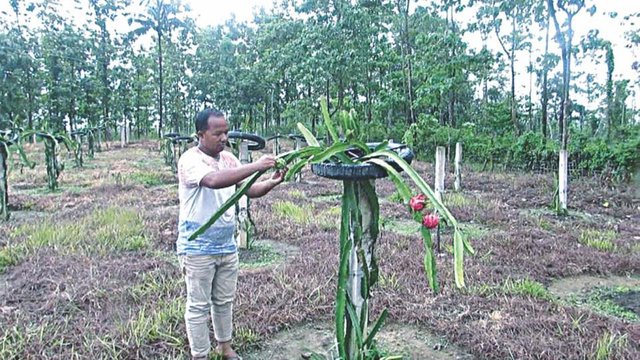# Change Maker: Dragon fruit kindles hope
Khagrachhari farmers expect good yield this season

A dragon fruit garden at Lalit Karbaripara in Khagrachhari. Four farmers, with assistance from the Khagrachhari Horticulture Centre, have set up such gardens in the hill district. Photo: Saikat Dewan
Originally from Mexico and nowadays common in Southeast Asia and China, the delectable dragon fruit, also called pitaya, is a relative newcomer to Bangladesh. Over the last few years in Khagrachhari, four innovative farmers have established gardens of the cactus with the aim of putting homegrown dragon fruit firmly on the culinary map.
With cultivation commencing in 2013, Khagrachhari Agro Garden in Maishchhari Guchhogram is both the oldest and the largest commercial producer of dragon fruit in the district. “We have 550 dragon fruit cacti,” says its caretaker Mohammad Julhas. “We harvested the first fruit last year and expect around 150 bushes to produce fruit this season. So far, we have produced around 200 kilograms of dragon fruit which means earnings of at least Tk 1 lakh," he said while talking to The Daily Star last month.
He says their garden has been established with the assistance of the Khagrachhari Horticulture Centre and that this year the predicted harvest should amount to a minimum of 250 kilograms.
Each cactus bush is grown attached by a rubber tie to a concrete pillar for support. The plant usually flowers overnight, with blooms wilting by morning. Dragon fruit cacti rely on nocturnal pollinators such as moths and bats for fertilisation. While several self-fertile varieties exist, cross-pollinating varieties usually produce more and better quality fruit.
“Dragon fruit actually doesn't need much care,” says Rustam Ali, the caretaker of another garden. “Yields stretch across five months of the year. It's a very profitable enterprise.” He is likewise grateful to the horticulture centre for training and advice.
Talking to this newspaper last month, Samor Tripura said he planted dragon fruit seeds in Lalit Karbari Para of the district last year. “I visited the Khagrachhari Agro Garden and became interested in growing the fruit,” he says. “I've sown seeds in 130 bushes and already around forty are bearing fruit. I hope from the next year to achieve full production.”

Samor Tripura, one such farmer, takes care of a dragon fruit cactus plant at his garden. The photos were taken recently. Photo: Saikat Dewan
“Dragon fruit cacti can cope well with lower rainfall,” says Director of the horticulture centre Muazzem Hossain. “It's a major crop in countries like Thailand, Vietnam, Malaysia and Indonesia. We hope it can do well here in the hill districts too.” The horticulture centre is providing farmers with seeds and technical assistance to encourage dragon fruit production.
Many locals, potential consumers, are unfamiliar with the dragon fruit thus far; but by all accounts the dragon fruit is likely to prove popular. “People in this region don't know the dragon fruit,” says farmer Halshimang Chowdhury from Mohalchhari upazila. “But the fruit and its juice are really delicious. I am confident it will rapidly gain popularity.”